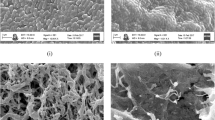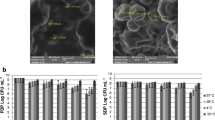Abstract
Synbiotics offer potential in the prophylactic management of gastrointestinal disorders. Therefore, present study evaluates the effect of prebiotics (inulin and gum acacia) on Lactocaillus plantarum for developing a freeze-dried synbiotic product from the selected culture. L. plantarum exhibited the highest specific growth rate (0.23/h) in presence of inulin followed by gum acacia (0.22/h) and glucose (0.22/h). Preparation of the lyophilized synbiotic powder incorporating inulin or gum acacia and using non fat dry milk as base material was standardized. Throughout refrigerated storage for 90 days, viable counts (i. e. 8 to 9 log cfu/g) of the probiotic bacteria in the product remained high, while a considerable reduction in the counts was observed in the product stored at room temperature (25 ± 1 °C).


Similar content being viewed by others
References
Baati L, Fabre-Ga C, Auriol D, Blanc PJ (2000) Study of the cryotolerance of Lactobacillus acidophilus: effect of culture and freezing conditions on the viability and cellular protein levels. Int J Food Microbiol 59:241–247
Basavanna G, Prapulla SG (2011) Evaluation of functional aspects of Lactobacillus fermentum CFR 2195 isolated from breast fed healthy infants’ fecal matter. J Food Sci Technol; doi 10.1007/s13197-011-0345-9.
Bourquin LD, Titgemeyer EC, Fahey GC, Garleb KA (1993) Fermentation of dietary fibre by human colonic bacteria: disappearance of, short-chain fatty acid from and potential water-holding capacity, various substrates. Scand J Gastroenterol 28:249–255
Bryant TN (2004) PIBWin-software for probabilistic identification. J Appl Microbiol 97:1326–1327
Calame W, Weseler AR, Viebke C, Flynn C, Siemensma AD (2008) Gum arabic establishes prebiotic functionality in healthy human volunteers in a dose-dependent manner. Brit J Nutr 100:1269–1275
Carvalho AS, Silva J, Ho P, Teixeira P, Malcata FX, Gibbs P (2004) Effects of various sugars added to growth and drying media upon thermo tolerance and survival throughout storage of freeze-dried Lactobacillus delbrueckii spp bulgaricus. Biotechnol Prog 20:248–254
Cherbut C, Michel C, Raison V, Kravtchenko T, Meance S (2003) Gum acacia is a bifidogenic dietary fibre with high digestive tolerance in healthy humans. Microb Ecol Health Dis 15:43–50
Collins EB, Hall BJ (1984) Growth of bifidobacteria in milk and preparation of Bifidobacterium infantis for a dietary adjunct. J Dairy Sci 67:1376–1380
Crittenden R, Weerakkody R, Sanguansri L, Augustin MA (2006) Synbiotic microcapsules that enhance microbial viability during nonrefrigerated storage and gastrointestinal transit. Appl Environ Microbiol 3:2280–2282
Dhewa T, Bajpai V, Saxena RK, Pant S, Mishra V (2010) Selection of lactobacillus strains as potential probiotics on basis of in vitro attributes. Int J Prob Preb 5(1):45–52
FAO/WHO Experts’ Report (2001) Health and nutritional properties of probiotics in food including powder milk with live lactic acid bacteria: 1–10
Fazeli MR, Toliyat T, Samadi N, Hajjaran S, Jamalifer H (2006) Viability of Lactobacillus acidophilus in various vaginal tablet formulations. DARU 14:172–177
Gibson GR, Wang X (1994) Bifidogenic properties of different types of fructooligosaccharides. Food Microbiol 11:491–498
Gibson GR, Roberfroid MB (1995) Dietary modulation of the human colonic microbiota: introducing the concept of prebiotics. J Nutr 125:1401–1412
Gibson GR, Beatty ER, Wand X, Cumming JH (1995) Selective stimulation of bifidobacteria in the human colon by oligofructose and inulin. Gastroenterol 108:975–982
Gilliland SE (1989) Acidophilus milk products: a review of potential benefits to consumers. J Dairy Sci 72:2483–2494
Goetze O, Fruehauf H, Pohl D, Giarre M, Rochat F, Ornstein K, Menne D, Fried M, Thumshirn M (2008) Effect of a prebiotic mixture on intestinal comfort and general wellbeing in health. Brit J Nutr 100:1077–1085
Graciela FV, Graciela SG, Aida APRH, Guillermo O (1983) Protective effect of adonitol on Lactic acid Bacteria subjected to freeze–drying. Appl Environ Microbiol 45(1):302–304
Grizard D, Barthomeuf C (1999) Non-digestible oligosaccharides used as prebiotic agents: mode of production and beneficial effects on animal and human health. Reprod Nutr Dev 39:563–588
Holzapfel WH, Haberer P, Geisen R, Bjorkroth J, Schillinger U (2001) Taxonomy and important features of probiotic microorganisms in food and nutrition. Am J Clin Nutr 73:365S–373S
Hopkins MJ, Cumming JH, Macfarlane GT (1998) Interspecies differences in maximum specific growth rates and cell yields of bifidobacteria cultured on oligosaccharides and other simple carbohydrate sources. J Appl Microbiol 85:381–386
Hull RR, Conway PL, Evans AJ (1992) Probiotic foods: a new opportunity. Food Aust 44:112–113
Kaplan H, Hutkins RW (2000) Fermentation of fructooligosaccharides by lactic acid bacteria and bifidobacteria. Appl Environ Microbiol 66:2682–2684
Kaplan H, Hutkins RW (2003) Metabolism of fructo- oligosaccharides by Lactobacillus paracasei 1195. Appl Environ Microbiol 69(4):2217–2222
Kolida S, Tuohy K, Gibson GR (2002) Prebiotic effects of inulin and oligofructose. Br J Nutr 87(Suppl 2):S193–S197
Liong MT (2008) Roles of probiotics and prebiotics in colon cancer prevention: postulated mechanisms and in vivo evidence. Int J Mol Sci 9:854–863
MacBrain AJ, MacFarlane GT (1997) Investigations of bifidobacterial ecology and oligosaccharide metabolism in a three-stage compound continuous culture system. Scand J Gastoenterol 32:32–40
McLeanRoss AH, Eastwood MA, Brydon WG, Anderson JR, Anderson DMW (1983) A study of the effects of dietary gum arabic in humans. Ame J Clin Nutr 37:368–375
McLeanRoss AH, Eastwood MA, Brydon WG, Busuttil A, McKay LF (1984) A study of the effects of dietary gum arabic in the rat. Brit J Nutr 51:47–56
Meance S (2004) Gum acacia (Fibregum TM), a very well tolerated specific natural prebiotic having a wide range of food applications. Agro Food 1:24–28; 2:32–35
Mishra V, Prasad DN (2005) Application of in vitro methods for selection of Lactobacillus casei strains as potential probiotics. Int J Food Microbiol 103(1):109–115
Mishra V, Goswami P, Dabur R, Prasad DN (2008) Antibiotic susceptibility and in vivo studies of selected probiotic strains of Lactobacillus casei. Int J Prob Preb 3(1):15–20
Nagpal R, Yadav H, Puniya AK, Singh K, Jain S, Marotta F (2007) Potential of probiotics and prebiotics for synbiotic functional dairy foods: an overview. Int J Prob Preb 2:75–84
Oyarzabal OA, Conner DE (1995) In vitro fructooligo-saccharides utilization and inhibition of Salmonella spp. by selected bacteria. Poult Sci 74:1418–1425
Phillipsa GO, Ogasawarab T, Ushida K (2006) The regulatory and scientific approach to defining gum arabic (Acacia senegal and Acacia seyal) as a dietary fibre. Food Hydrocoll Special Rev:1–10
Sghir A, Chow JM, Mackie RI (1998) Continuous culture selection of bifidobacteria and lactobacilli from human faecal samples using fructooligosaccharides as a selective substrate. J Appl Microbiol 85:769–777
Stoyanova S, Geuns J, Hideg E, Van Den Ende W (2010) The food additives inulin and stevioside counteract oxidative stress. Int J Food Sci Nutr. doi:10.3109/09637486.2010.523416
Sudha N, Shobha Rani P, Agrawal R (2006) Studies on the stability and viability of a local probiotic isolate Pediococcus pentosaceus (MTCC 5151) under induced gastrointestinal tract conditions. J Food Sci Technol 43(6):677–678
Ziemer CJ, Gibson GR (1998) An overview of probiotics, prebiotics and synbiotics in the functional food concept: perspective and future strategies. Int Dairy J 8:473–479
Author information
Authors and Affiliations
Corresponding author
Rights and permissions
About this article
Cite this article
Dhewa, T., Pant, S. & Mishra, V. Development of freeze dried synbiotic formulation using a probiotic strain of Lactobacillus plantarum . J Food Sci Technol 51, 83–89 (2014). https://doi.org/10.1007/s13197-011-0457-2
Revised:
Accepted:
Published:
Issue Date:
DOI: https://doi.org/10.1007/s13197-011-0457-2




